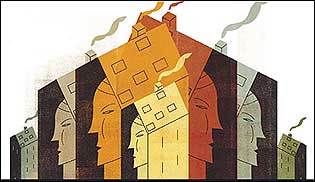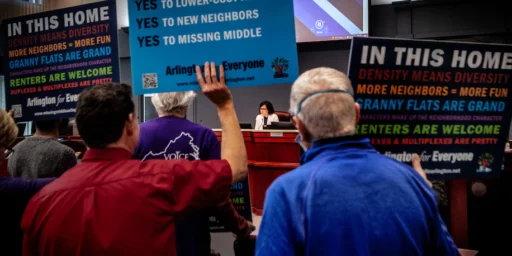Middle Class Disappearing in Major Cities
A few “superstar cities” are thriving but strangely have virtually no resident middle class, according to a recent Brookings study covered in today’s NYT.
SOME big American cities are flourishing as at no time in recent memory. Places like New York and San Francisco appear to be richer and more dazzling than ever: crime remains low, new arrivals pour in, neighborhoods have risen from the dead. New York is in the throes of the biggest building boom in 30 years, its population at an all-time high and climbing. Mayor Michael R. Bloomberg proudly promotes his city as “a luxury product.” But middle-class city dwellers across the country are being squeezed. This time, they are being squeezed out by the rich as much, or more so, as by the poor — a casualty of high housing costs and the thinning out of the country’s once broad economic middle. The percentage of middle-income neighborhoods in metropolitan areas like Los Angeles, Chicago and Washington has dropped since 1970, according to a recent Brookings Institution report.
[…]
Obviously, cities benefit economically from the presence of the rich. Tax revenues go up when the rich pour into what some economists now call “superstar cities,” places like New York, San Francisco, San Diego, Boston and Washington that attract highly skilled people but have limits on the ability to build housing. In New York, fewer than 13,000 of the 2.3 million households that pay income tax are expected to account for nearly 30 percent of city income tax paid in 2006.
In the San Francisco Bay Area, the percentage of households earning more than $100,000 a year rose to over 30 percent in 2000 from approximately 7 percent in 1970, said Joseph Gyourko, a professor of real estate and finance at the Wharton School of the University of Pennsylvania. “Is that area worse off?” he asked. “At least so far, there’s a lot of evidence that economically they’re better off. Land prices are really high, lots of people want to move there.”
Edward L. Glaeser, a Harvard economist who studied 300 large cities with a range of levels of income inequality in the 1960’s and 1970’s, says he found little evidence that those levels later affected the growth of housing prices, income or population there. Of course, cities need police officers, firefighters, teachers. But as long as they can get the labor they need from somewhere nearby, some economists say, middle-class shrinkage may not hurt. In Southern California, developers import construction workers from Las Vegas and put them up in hotels; costs go up but rich clients can pay. Firefighters who want to live in high-priced cities can work two jobs, said W. Michael Cox, chief economist for the Federal Reserve Bank of Dallas. “I think it’s great,” he said. “It gives you portfolio diversification in your income.” Pay for essential workers like plumbers and cabdrivers will tend to go up, he said.
Professor Glaeser said: “There’s no obvious smoking gun saying cities will be substantially worse off. There’s a whole lot of America that does a very good job of taking care of the middle class. The great sprawling edge cities of the American hinterland provide remarkably cheap housing, fast commutes, decent public services and incredibly cheap products available in big box stores. As a New Yorker, I understand the view that exile from New York is consignment to hell; but that’s not accurate. The majority of middle-class people that have moved out have presumably found themselves better lives out there.”
But sociologists and many economists believe that there can be non-economic consequences for cities that lose a lot of middle-income residents. The disappearance of middle-income neighborhoods can limit opportunities for upward mobility, the authors of the Brookings study said. It becomes harder for lower-income homeowners to move up the property ladder, buy into safer neighborhoods, send their children to better schools and even make the kinds of personal contacts that can be a route to better jobs. The Brookings study, which defined moderate-income families as those with incomes between 80 and 120 percent of the median for each area, found that the percentage of middle-income neighborhoods in the 100 largest metropolitan areas had dropped to 41 percent from 58 percent between 1970 and 2000. Only 23 percent of central city neighborhoods in 12 large metropolitan areas were middle income, down from 45 percent in 1970.
[…]
With a dwindling middle class, rich and poor become more separate. Alan Berube, an author of the Brookings study, said a two-tiered marketplace can develop: Whole Foods for the upper classes, bodegas for the lower, with no competition from stores courting the middle. “If the two models are check cashers on the one hand and major national financial institutions on the other, who’s thinking about how to hold down costs for the basic consumer?” he asked.
These options are presented as if they are mutually exclusive; they aren’t. Taking the D.C. area as an example, given that I live here, the reason for the bifurcation is not surprising: simple supply and demand. The city is tiny and the fraction available for residential development is much smaller. There are essentially no single family homes available and even small townhouses in even remotely desireable communities are selling for over $1 million. Conversely, delipidated housing in Anacostia is relatively affordable but rather unappealing to most of the middle class. Most of us in the middle class, especially those not employed in D.C. proper, therefore chose to live in the suburbs where those insane housing prices at least afford one a decent home in a decent community. With a parking spot and everything.
Further, Professor Glaeser is exactly right: Living in the suburbs is, for most of us, not hell. Indeed, while I enjoy many of the amenities of D.C. and may wind up employed there at some point, living there simply has no appeal to me. Not having grown up in a city, my idea of a decent middle class lifestyle does not involve a 900 square foot townhouse with a 10×10 backyard in a high crime area. And we’ve got Whole Foods in the ‘burbs, too.





